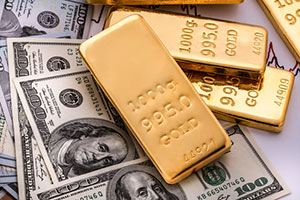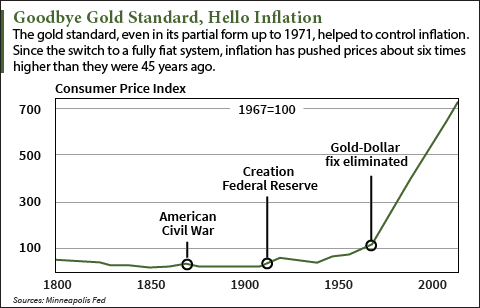 A return to the gold standard, long a goal of many conservatives, is a lot less far-fetched now that Donald J. Trump is headed to the White House in January 2017.
A return to the gold standard, long a goal of many conservatives, is a lot less far-fetched now that Donald J. Trump is headed to the White House in January 2017.
It's been 45 years since the United States used any form of the gold standard. Proponents of the gold standard - tying the U.S. dollar to gold - say it would stop the erosion in the currency's value, limit runaway government spending, and foster economic growth.
But apart from a few vocal fans, such as retired Rep. Ron Paul (R-TX), most policymakers in recent years have viewed the gold standard as an outdated idea. Or, as iconic economist John Maynard Keynes famously called it, a "barbarous relic."
The election of Trump has changed the calculus, however. Judging by what he has said and who he has consulted with, it's clear that Trump is at least willing to entertain the idea of a return to the gold standard.
Here's what that would mean...
What Is the Gold Standard?
At its most basic, a gold standard currency is one backed by gold, although it could be another precious metal like silver.
In this system, a country fixes the price of gold in its currency, buying and selling gold only at that price. In other words, the currency is fully convertible between paper notes and gold.
In 1879, the U.S. government set the gold price at $20.67 an ounce. So you could take $20.67 in U.S. currency to a bank and, if you so desired, could trade it for one ounce of gold. Under this type of gold standard, governments can only create money if they have the gold to back it up.
This greatly restrains government spending (and inflation).
With some brief exceptions during World War I, the United States stayed on the gold standard until 1933. That's when President Franklin Roosevelt ended gold convertibility for individuals and made it illegal for American citizens to own gold. Roosevelt shortly after re-set the price of gold to $35 an ounce so he could print more money to fund New Deal programs.
After World War II, the United States maintained a partial gold standard in which foreign countries could convert their U.S. dollars to gold. President Richard Nixon put a stop to that in 1971, the so-called "Nixon Shock."
Since then, gold prices have skyrocketed 3,250%, the U.S. dollar has lost 83% of its buying power, and the national debt is 50,000 times bigger, having soared from $400 million to nearly $20 trillion.

No wonder people are nostalgic for the gold standard. There's a high level of GOP interest in it, including from those in Trump's circle of influence...
Widespread Support for the Gold Standard in Trumpdom
One of those "influencers" is Dr. Judy Shelton, a senior fellow and co-director of the Atlas Sound Money Project and a member of Trump's economic advisory team. She has a long history of advising Republican candidates. She's worked with New York Congressman Jack Kemp (who ran for president in 1988 and was Sen. Bob Dole's running mate in 1996), Florida Sen. Marco Rubio, and Texas Sen. Ted Cruz.
"Some people may think of that as a throwback, but I see it as a sophisticated, forward-looking approach because gold is neutral and it's universal," Shelton told Fortune in an August 2016 interview. "It's a well-accepted monetary surrogate that transcends borders and time."
Late last month, Trump met with John Allison, IV, a president of the Cato Institute as well as a former CEO of BB&T Corp. (NYSE: BBT). Allison was under consideration for the cabinet post of Secretary of the Treasury, which ultimately went to former Goldman Sachs Group Inc. (NYSE: GS) partner Steve Mnuchin.
A libertarian thinker, Allison favors abolishing the U.S. Federal Reserve in addition to returning to the gold standard.
"We need a private, free-banking system based on a market standard such as gold," Allison wrote in a 2014 paper for the Cato Journal. "If the United States had continued with the classical gold standard instead of having instituted a government money monopoly in 1913, we would have learned through experimentation, as all markets do, and would have a radically better financial system and higher economic growth today."
Editor's Note: An incredibly rare gold market anomaly is shaping up in the markets as we speak - one that has occurred ONLY twice in the past 20 years. And it's about to happen again. Details here...
Support for the gold standard can even be found in the 2016 Republican Party platform, although it couches it in fuzzy language. The platform proposes a "commission to investigate possible ways to set a fixed value for the dollar" similar to one created by President Ronald Reagan in 1981 to consider a "metallic basis" for the dollar.
Of course, Trump himself has discussed the possibility of a return to the gold standard.
"Bringing back the gold standard would be very hard to do, but boy, would it be wonderful. We'd have a standard on which to base our money," Trump said in a GQ interview last month.
But turning back the clock is easier said than done...
Why Trump Won't Bring Back the Gold Standard in 2017
Despite all the talk about returning to the gold standard, it has almost zero chance of actually happening.
While the benefits are real enough, adhering to a gold standard has drawbacks as well - most of which are political poison.
While a gold standard does a good job of keeping a lid on inflation, it makes deflation more likely. That's when prices are dropping, rather than rising. It happens when the gold supply can't keep pace with economic growth.
That might sound good, but it cripples the economy because it slows consumer spending - people know goods will get cheaper if they wait. And businesses struggle to make a profit as they're forced to charge less for their products.
The biggest political obstacle to returning to the gold standard, though, is the constraints it puts on government money printing.
Most governments today run large budget deficits. Few, if any, have the stomach to make the huge budget cuts necessary to operate under a gold standard.
But a gold standard also ties a government's hands in times of war or a severe economic crisis, when deficit spending is unavoidable. That's why governments were forced to suspend the gold standard during World War I and why many abandoned when the Great Depression struck.
Finally, there's a practical consideration that makes it virtually impossible to return to the gold standard...
The Gold Standard Would Destroy the Dollar Before It Saved It
Massive inflation since 1971 would require the price of gold to be set much higher than the current $1,173. Much higher.
West Shore Group chief global strategist Jim Rickards has calculated the gold price would need to be $10,000 an ounce.
That would severely devalue the dollar. The price of something that cost $1 would quickly rise to $8.50. That's a loss of 88% of the dollar's buying power. So debtors would rejoice while savers would be wiped out.
Markets would be upended. Global trade, which relies on the U.S. dollar as a reserve currency, would likely grind to a halt. The resulting economic catastrophe would make the 2008 financial crisis look trivial.
Keeping the price of gold anywhere near where it is now would force deflation on the same scale. Prices would plummet, triggering a deep 1930s-style depression. The return to the gold standard following the Civil War did just that in 1873, launching a 65-month depression.
This is probably why zero out of 40 economists surveyed by the University of Chicago's Initiative on Global Markets Forum in 2012 thought the U.S. economy would be better off under a gold standard.
Next Up: Gold standard or not, the yellow metal is severely undervalued right now. But while investors can't go wrong by stocking up on gold, there's a better way to play it that can multiply your returns many times over. You could make 100 times your money on this under-the-radar investment...
Follow me on Twitter @DavidGZeiler or like Money Morning on Facebook.
About the Author
David Zeiler, Associate Editor for Money Morning at Money Map Press, has been a journalist for more than 35 years, including 18 spent at The Baltimore Sun. He has worked as a writer, editor, and page designer at different times in his career. He's interviewed a number of well-known personalities - ranging from punk rock icon Joey Ramone to Apple Inc. co-founder Steve Wozniak.
Over the course of his journalistic career, Dave has covered many diverse subjects. Since arriving at Money Morning in 2011, he has focused primarily on technology. He's an expert on both Apple and cryptocurrencies. He started writing about Apple for The Sun in the mid-1990s, and had an Apple blog on The Sun's web site from 2007-2009. Dave's been writing about Bitcoin since 2011 - long before most people had even heard of it. He even mined it for a short time.
Dave has a BA in English and Mass Communications from Loyola University Maryland.



